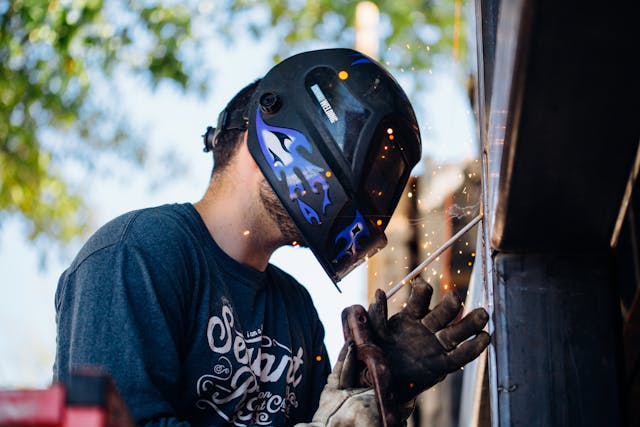A reliable pair of welding gloves is one of the most crucial pieces of safety equipment for any welder. The right pair can protect you from extreme heat, electric shock, and sharp metal edges. However, choosing the right welding gloves can be overwhelming, with many types and styles available. This comprehensive guide will explore the welding gloves best practices for using welding gloves effectively, ensuring both safety and optimal performance.
Importance of Welding Gloves
Welding gloves are designed to protect welders from a variety of hazards, including:
- Welding involves high temperatures that can cause severe burns. Gloves made from heat-resistant materials like leather are essential for protection.
- During welding, molten metal can splatter, posing a risk of burns. Gloves shield the hands from these sparks.
- Welding produces harmful ultraviolet and infrared radiation. Gloves help to minimize exposure.
- Certain welding processes, such as arc welding, carry a risk of electrical shock. Insulated gloves provide an additional layer of safety.
- Handling sharp or rough materials can lead to cuts and abrasions. Welding gloves offer protection against such injuries.
Types of Welding Gloves
Different welding processes require different types of gloves. The three main types of welding gloves are:
1. Stick Welding Gloves
These gloves are heavy-duty, offering maximum protection against heat and sparks. They are typically made from cowhide or elk skin.
2. MIG Welding Gloves
MIG (Metal Inert Gas) welding gloves are designed for agility and flexibility while providing good protection. They are usually made from pigskin or cowhide.
3. TIG Welding Gloves
TIG (Tungsten Inert Gas) welding gloves require the highest level of skill. They are thinner than other welding gloves and are often made from goatskin or deerskin.
Selecting the Right Welding Gloves
Choosing the right welding gloves is crucial for safety and performance. Consider the following factors:
Material
The type of material affects the glove’s durability, flexibility, and heat resistance. Common materials include cowhide, pigskin, deerskin, and goatskin.
Fit and Comfort
Gloves should fit snugly but not be too tight. A good fit ensures better control and reduces fatigue. Look for gloves with an ergonomic design and padded linings for extra comfort.
Heat Resistance
Ensure the gloves can withstand the temperatures you will be working with. Higher heat resistance is necessary for processes like stick welding.
Dexterity
Depending on the welding process, you may need gloves that allow for more excellent dexterity. TIG welding, for instance, requires gloves that permit precise movements.
Cuff Length
Longer cuffs provide additional forearm protection, especially when welding overhead or in tight spaces.
Durability
High-quality gloves from durable materials will last longer and provide better protection.
Best Practices for Using Welding Gloves
To maximize the effectiveness of welding gloves, follow these welding gloves best practices.
Regular Inspection
Before each use, inspect your gloves for any signs of wear, holes, or damage. Replace gloves that show significant wear to maintain protection.
Proper Storage
Store gloves in a cool, dry place away from direct sunlight and moisture. Avoid folding them to prevent cracks and creases.
Cleanliness
Clean your gloves by brushing off debris and wiping them down with a damp cloth. Avoid using harsh chemicals or soaking them in water, as this can damage the material.
Correct Usage
Use the right gloves for the welding process you are performing. Do not use gloves designed for TIG welding when stick welding, as they may not provide adequate protection.
Avoiding Cross-Contamination
Design specific gloves for different tasks to avoid cross-contamination, especially when working with hazardous materials.
Enhancing Performance with the Right Gloves
Effective use of welding gloves is essential for both safety and performance in welding. Using suitable welding gloves can significantly enhance performance with welding gloves. Here are some welding glove safety tips to help you get the most out of your gloves:
Comfort and Fit
Choose gloves that fit well and are comfortable for extended periods. Too tight gloves can restrict movement, while loose gloves can reduce control.
Flexibility
For processes that require precision, such as TIG welding, opt for gloves that offer good flexibility and tactile sensitivity.
Grip
Ensure that the gloves provide a good grip. Some gloves have textured palms to improve grip, which can be particularly useful when handling materials.
Breathability
The gloves' breathability is a crucial factor to consider. Look for gloves with breathable linings to keep your hands cool and reduce sweating, which can improve comfort and control.
Layering
In extremely high-heat environments, layering your gloves with an additional pair of heat-resistant liners is a safety measure you should consider for extra protection.
Welding Glove Maintenance
Proper maintenance of welding gloves is essential to ensure their longevity and effectiveness. Here are some welding glove safety tips for welding glove maintenance:
- Keep your gloves clean by brushing off debris and wiping them down with a damp cloth. Avoid using harsh chemicals or soaking them in water, as this can damage the material.
- Store gloves in a cool, dry place away from direct sunlight and moisture. Avoid folding them to prevent cracks and creases.
- Regularly inspect your gloves for any signs of wear, holes, or damage. Replace gloves that show significant wear to maintain protection.
- Keep gloves away from oil, grease, and other contaminants that can weaken the material.
Common Mistakes to Avoid
Avoiding common mistakes can help you use welding gloves more effectively:
- Using gloves not designed for welding or the wrong type of welding gloves for a specific process can compromise safety and performance.
- Failing to maintain and inspect gloves regularly can lead to the use of gloves that are no longer effective.
- Disregarding the importance of comfort can result in reduced productivity and increased risk of injury.
- Improperly storing gloves can cause damage and reduce their lifespan.
Conclusion
Effective use of welding gloves is essential for both safety and performance. By understanding the importance of different types of gloves, choosing the right welding gloves for the job, and following welding gloves' best practices for their use and maintenance, welders can protect themselves from hazards and enhance their work quality.
By incorporating these welding gloves' best practices into your routine, you can ensure that your welding gloves provide maximum protection and performance, allowing you to focus on the craft and achieve the best results.
Strongarm is the leading welding manufacturer and provider in America. We have a team of trusted professional welders offering a wide range of welding aprons and gears to suit your needs. Contact us today for all your weldings essentials.






